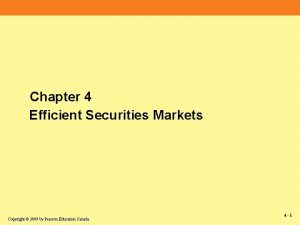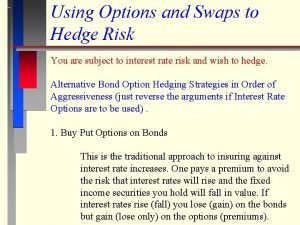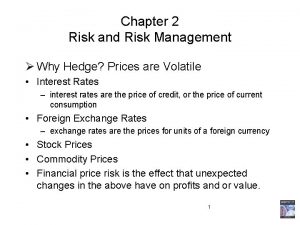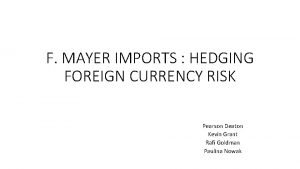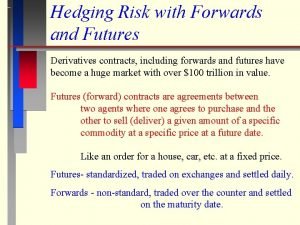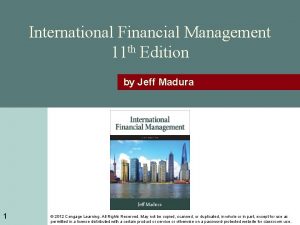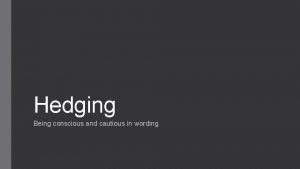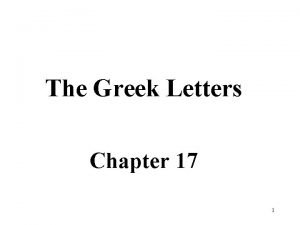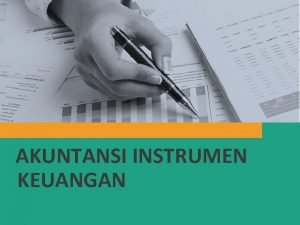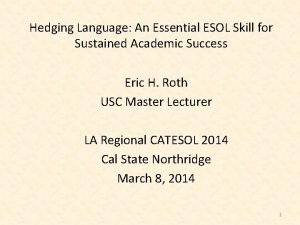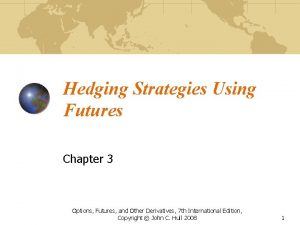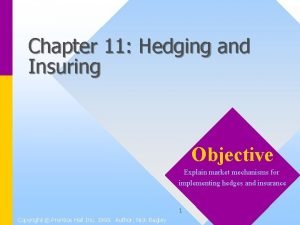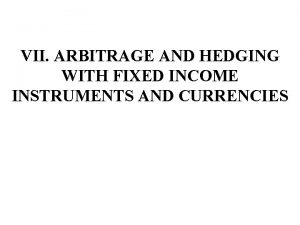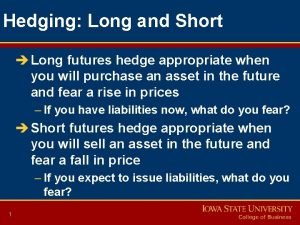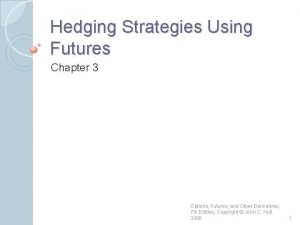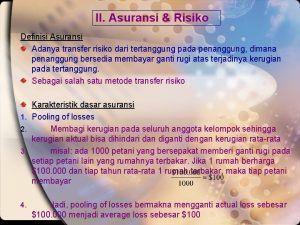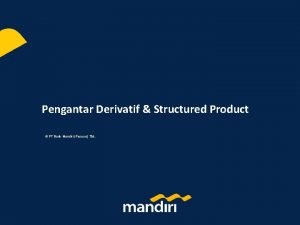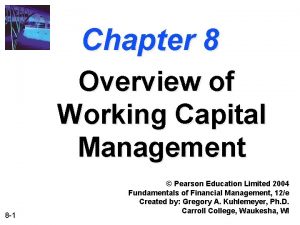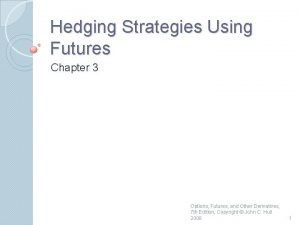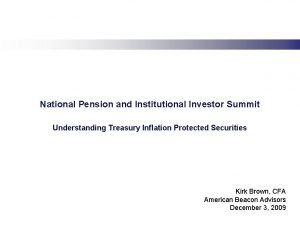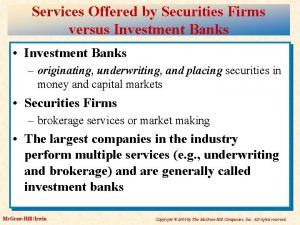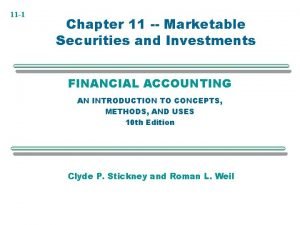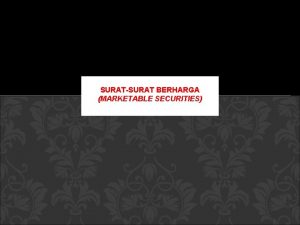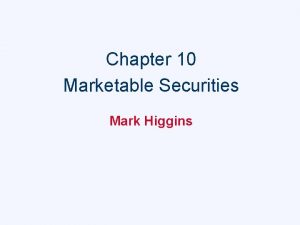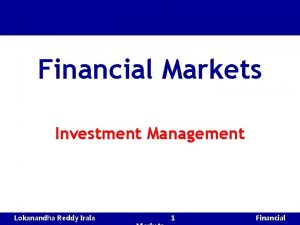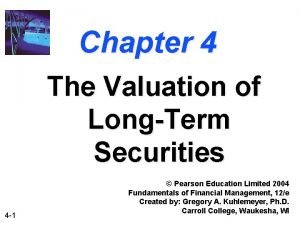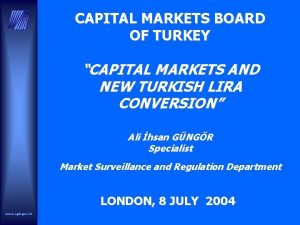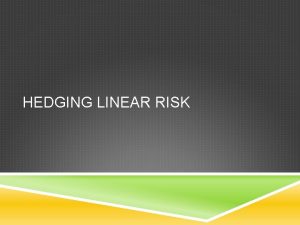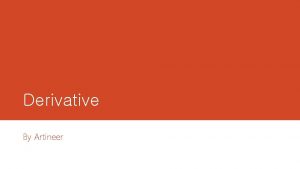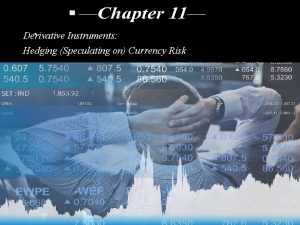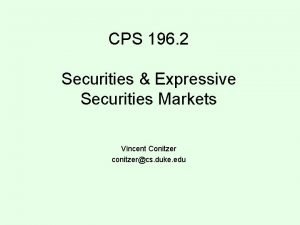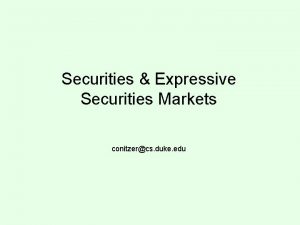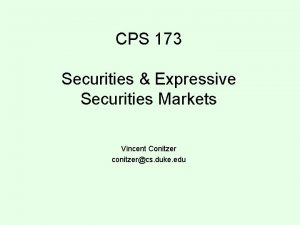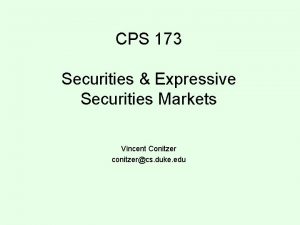Hedging Risk Derivative Securities Derivative Markets l l
























































- Slides: 56

Hedging Risk Derivative Securities

Derivative Markets l l l Derivative markets are a relatively new phenomenon, but are one of the most rapidly growing asset classes. Currently, there approximately 300 million derivative contracts outstanding with a market value of around $50 Trillion While equity trading is centered in New York (NYSE, NASDAQ), derivative markets are centered in Chicago (CME, CBOT, CBOE)

What is a Derivative l l A derivative is simply a contract which entitles the holder to buy or sell a commodity at some future date for a predetermined price. Therefore, while a stock or a bond has intrinsic value (a stock or a bond represents a claim to some asset or income stream), a derivative has no intrinsic value. Its value is “derived” from the underlying asset.

Futures Contracts l l A futures contract is an obligation to buy/sell a specific quantity of a specific commodity at a future date for a predetermined price. l The buyer of the future (long position) is required to purchase the commodity l The seller of the future (short position) is required to deliver the commodity For example, A July wheat future obligates the buyer to purchase 5, 000 bushels (FND 6/28, LTD 7/12) for a price of 293 cents/bushel between 6/28 – 7/12.

Futures Contract l In this example, the long position earns a profit of $. 58 per bushel times 5, 000 bushels equal $2, 900. Note that the short position loses $2, 900.

Types of Futures Currencies Agriculture Metals & Energy Financial British Pound Lumber Copper Treasuries Euro Milk Gold LIBOR Japanese Yen Cocoa Silver Municipal Index Canadian Dollar Coffee Platinum S&P 500 Mexican Peso Sugar Oil DJIA Cotton Natural Gas Nikkei Wheat Cattle Soybeans

Hedging Risk With Futures Suppose you are a wheat farmer, your income is strongly tied to the price of wheat l Specifically, you are concerned about falling wheat prices l Therefore, you would like to take a short position in wheat futures l

Who will take the long position? A flour producer would use wheat as an input to production. Therefore a flour producer might be concerned about rising wheat prices. l To hedge this risk, the flour producer would want to take a long position in wheat futures l

The dealers place orders with their pit traders, who strike a deal.

Once the deal is made, the deal is sent to the clearinghouse, who will act as the middleman

Why is a middleman required? l Recall that, unlike stocks or bonds, derivatives have future obligations attached to them. The clearinghouse is just an efficient way to insure compliance with the terms of the contract.

Settlement day The wheat future requires delivery/purchase of wheat upon expiration. This, however, rarely (if ever) actually happens. If the commodity is actually “delivered”, its simply a question of identifying ownership. The most common procedure would be a canceling out of the contract by issuing an identical contract of equal size, but opposite position at the current spot price. Upon settlement, the profit would be (F-S) for the farmer, and (S-F) for the flour producer.

Hedging Interest Rate Risk l l l Suppose that you have purchased a 10 year T-Bond with a face value of $100, 000. What risks do you face? How can you hedge that risk? You bond price will fall if interest rates rise. Therefore, you would want to take a short position in an interest rate future. What type of future should you sell?

Suppose you hedge with 13 Week T-Bill Futures For every 1% rise in interest rates, you T-Bond drops by approximately $7, 500 in value (10 yr Treasuries have a duration of approximately 7. 5) If you take a short position in T-Bill futures (the standard size is $1, 000). For every 1% increase in interest rates, you would earn $2, 500 (90 day T-Bills have a duration of. 25). Therefore, you would need to buy 3 contracts. Further, this T-Bill hedge only protects you from interest rate risk – not yield curve risk. Note that your ratio of futures to forwards is 30: 1. This is no coincidence!

What should the futures price be? As a first pass, remember that no one should expect to make profits in the market. Therefore, the future’s price should equal the expected future spot price; F = E(S’) However, it is also reasonable to believe that because futures are being used to hedge risk, the buyers/sellers would be willing to pay a premium for that hedge. In the wheat example, the farmer should be willing to pay a future price below the future spot price (F<E(S)) while the flour producer should be willing to pay a price higher that the future spot price (F>E(S)) Modern portfolio theory assumes that fluctuating commodity prices represent a source of systematic risk to financial portfolios. Therefore, because futures can alleviate this risk, they should sell at a discount.

Pricing Futures l To price a future its important to recognize that there are several ways to generate a given cash flow. Any two methods that generate the same cash flow should have the same cost!

Currency Futures l Suppose that an October 2005 contract for Euros costs $1. 25 per Euro. l By going long on this contract, you can buy Euro in one year for $1. 25 apiece. How else can you acquire Euro in one year at a fixed price with no money up front? l Borrow money today to buy a Euro denominated asset.

Currency Futures l Suppose that the interest rate on ECB bonds is 4%. How much would an ECB bond with a face value of 1 Euro cost?

Currency Futures l If the current exchange rate is $1. 20 per euro, we can figure out what we need to borrow today to buy the bond.

Currency Futures If we borrowed this amount at a 6% annual interest rate, what would you owe tomorrow This gives us the same Euro that we could by in the futures market for $1. 25!

Currency Futures l The general condition can be written as follows:

Index/Commodity Futures l Suppose an October S&P 500 index future was selling for $1, 150 (This future allows you to buy one share of the index). l Alternatively, suppose that you borrowed money today to buy a bond that would pay out enough to purchase a share of the index with certainty next year.

Index/Commodity Futures l The expected payout to this bond would be next year’s index value. To get the bond’s price, we discount by an interest rate that reflects the bond’s risk (say, the return to the S&P 500)

Index/Commodity Futures l Now, because we borrowed this amount today (at the T-Bill rate), we will owe our loan amount plus interest next year.

Index/Commodity Futures l For example, if the S&P 500 index was expected to sell for $1, 250 next year (the average return on the index is 10%) and the T-Bill rate was 4%, we could buy a share of the index today for $1, 182

Index/Commodity Futures l l Again, the general relationship can be written as follows. The more variable market ‘x’ is, the larger the interest rate associated with market ‘x’ and, hence, the cheaper the future price will be.

Options vs. Futures l Recall that a futures contract is an obligation to deliver or purchase a specific commodity as a predetermined time & price

Options vs. Futures l l Recall that a futures contract is an obligation to deliver or purchase a specific commodity as a predetermined time & price An option contract gives the holder the option to buy or sell a specific commodity at a predetermined time & price Only the purchaser (long position) of the contract gets the option. The seller (short position) has to obligation to buy/sell if the option is exercised. An option, however, does have an up front cost (the price of the option)

“Vanilla” Options Any option is defined by four characteristics: commodity, size, exercise (strike) price, and term. l A call option gives the holder the option to purchase a commodity at the strike price l A put option fives the holder the option to to sell a commodity at the strike price l

Variations on Exercising l l l A European option can only be exercised upon expiration An American option may be exercised at any time up to the expiration date of the contract A Bermuda (Mid Atlantic) option has several potential exercise dates over the life of the contract (monthly, quarterly, etc)

Variations on Payout l l l Average (Tokyo) option: the payout is equal to the average commodity price over the contract’s lifetime minus the strike price Look back options: The strike price is equal to the minimum (call)/maximum (put) of the underlying commodity Ladder options: Gains are “locked in“ once the commodity hits predetermined price levels

“Exotic” Options l l l One example of an “exotic” would be a barrier option. In addition to a strike price, a barrier option has one (single barrier option) or two (double barrier option) “trigger” prices. For knock out options, if a trigger is crossed, the option is voided For knock in options, the option is activated once the trigger price has been hit The direction of the price change also matters: “down and in” “down and out” , “up and in” , “up and out”

Why use options?

Why use options? Hedging: as with futures, options can be used to insure against many different types of risk l Speculation: as with futures, an option is basically a bet as to the direction/magnitude of a commodity price. l

A Protective Put A protective put involves the purchase of a stock and a put on that stock in equal quantities l The combined value of the stock/put will never be lower than the strike price of the put. l A protective put is like buying insurance against price declines. l

Protective Put l On the right is the payout to buying a put with a strike price of $30.

Protective Put l Combine the put with a share of the underlying stock.

Covered Call A covered call involves buying a stock and selling a call in equal proportions. l The combination of the call/stock will never rise above the strike price of the call. l This strategy might be used to collect income of a rising stock price without paying capital gains taxes l

Covered Call l On the right is a the payout from selling a call with a strike price of $30.

Covered Call l Combine the call with the stock

Straddle A straddle involves buying a put and a call on a stock (with equal strike prices) in equal proportions l A straddle benefits from both price increases and decreases, but might be quite costly l Strips and straps involve different proportions of puts/calls l

Straddle l On the right is a the payout from buying a call with a strike price of $30. On the Left is the payout from buying a put with the same strike price.

Straddle l Combine the two to get a straddle. Note that a straddle benefits from both price increases and decreases, but is quite expensive.

Collar l l l A collar involves the simultaneous purchase of a call and sale of a call at different strike prices The combined value of the two calls will be bounded above and below. Further, the cost of the purchased call is offset by the revenues from the written call A swap is essentially a collar with a zero spread

Straddle l On the right is a the payout from buying a call with a strike price of $30. On the Left is the payout from selling a call with a strike price of $35.

Straddle l The collar is very cheap because you use the proceeds from the sale of one derivative to buy the other.

Put/Call Parity l l Recall the protective put constructed earlier (1 stock, 1 put) This payout can be replicated by purchasing a call option and a Treasury in equal proportions Because these two portfolios have the same payout, they must have equal cost. This defines a relationship between call prices and put prices The put/call parity condition is written as C + X/(1+rf)^T = S + P

Option Pricing l l There is no guarantee that an option will actually be exercised. This greatly complicates the pricing of these contracts. Conceptually, we know call option prices should have the following characteristics: l l l Positively related to the commodity price Negatively related to the strike price Positively related to the variance of the underlying commodity Positively related to the term Negatively related to the real interest rate

Binomial Pricing Binomial pricing involves constructing a lattice for possible movements of the underlying asset’s price. l At each point on the tree, it is possible to replicate the return from a call option with a combination of stock and a bond. l If two assets have the same returns, they should have the same price! l

Example Suppose a share of stock is currently selling for $20. It has an equal chance of increasing to $25 or falling to $15 tomorrow. l There is a risk free bond selling for $1 today. If the interest rate is 6%, the bond will be worth $1. 06 tomorrow. l Consider a call option with a strike price of $20. l

Example There are two states of the world tomorrow: State 1: State 2 S = $25 S = $15 C = $0 B = $1. 06 l Suppose we buy X shares of the stock today and Y shares of the bond. What is our payout tomorrow? We need to choose a combination of X and Y to replicate the call payout State 1: $25 X + $1. 06 Y State 2: $15 X + $1. 06 Y $25 X + $1. 06 Y = $5 $15 X + $1. 06 Y = $0 Solving for X and Y, we get X =. 5 (1/2 Share of Stock) Y = -7. 08 (Borrow $7. 08) The Cost of. 5 Shares today (net of borrowing $7. 08) is. 5($20) - $7. 08 = $2. 92 This is the value of the call!!

Black/Scholes (1973) l l l The key bit of logic behind the Black/Scholes option pricing framework is that it is always possible to construct a portfolio of call options and the underlying commodity in such a way as to eliminate all risk Recall that a risk free portfolio should pay the risk free rate of return to eliminate any potential arbitrage opportunities. This no arbitrage condition results in a relationship between the call price and the underlying fundamentals The biggest limitation to the Black/Scholes framework is that it can only be used to price European options

Black/Scholes (1973)

Pricing American Options l l l The problem with pricing American options is that they are “path dependant” For example, suppose that a call option on IBM stock is purchased with a strike price of $85. The current Price of IBM stock is $85. What will that option be worth in a month? IBM stock traded at a constant $85 for the entire month and then jumped to $90. In this case, the option would be worth around $5. However, if IBM stock rose to $150 and then dropped to $90, the option would probably have already been exercised. Therefore, its not just the stock price that matters. It also matters how it got there.

Swaps l l A swap is simply a contract in which one payment stream is traded (swapped) for another The most common swap is a variable/fixed rate interest swap in which interest rate payments on a variable rate loan are traded for interest rate payments on a fixed rate loan Swaps can also be created for currencies, commodities, stocks, etc. Recall, that a swap is basically a zero spread collar. Therefore, the same principles used for pricing options are used for pricing swaps.

Other option combinations l The underlying commodities themselves can be derivative securities. l You can buy options on futures (i. e. , the option to enter into a futures contract) l Options on swaps are known as swaptions l Options on options are known as compound options
 Efficient securities markets imply that
Efficient securities markets imply that Hedging interest rate risk with futures
Hedging interest rate risk with futures Hedging credit risk with options
Hedging credit risk with options Hedging manages risk that are manageable
Hedging manages risk that are manageable F mayer imports
F mayer imports Market risk credit risk operational risk
Market risk credit risk operational risk Hedging and forward contracts
Hedging and forward contracts Mortgage hedging 101
Mortgage hedging 101 Hedging receivables and payables
Hedging receivables and payables Cautious language
Cautious language Delta neutral hedging in surat
Delta neutral hedging in surat Imperfect hedge
Imperfect hedge Hedged item and hedging instrument examples
Hedged item and hedging instrument examples Hedging language exercises
Hedging language exercises Tailing the hedge
Tailing the hedge Instrumen keuangan derivatif
Instrumen keuangan derivatif Main objective of hedging
Main objective of hedging Academic style example
Academic style example Fixed income hedging
Fixed income hedging Oil hedging definition
Oil hedging definition Hedging adalah
Hedging adalah Hedge ratio
Hedge ratio Hedging strategies using futures
Hedging strategies using futures Transfer risiko
Transfer risiko Hedging adalah
Hedging adalah Static hedging of exotic options
Static hedging of exotic options Hedging basics
Hedging basics Hedging and boosting
Hedging and boosting Hedging in writing
Hedging in writing Hedging approach of working capital
Hedging approach of working capital Hedge ratio formula
Hedge ratio formula Medium-term risk examples
Medium-term risk examples Risk projection
Risk projection Ar = ir x cr x dr
Ar = ir x cr x dr Risk map
Risk map Ar = ir x cr x dr
Ar = ir x cr x dr Pembelanjaan resiko
Pembelanjaan resiko Risk avoidance insurance
Risk avoidance insurance Business risk vs financial risk capital structure
Business risk vs financial risk capital structure Attributable risk
Attributable risk Absolute risk vs relative risk
Absolute risk vs relative risk The biggest risk is not taking any risk
The biggest risk is not taking any risk Relative risk calculation
Relative risk calculation Relative risk
Relative risk Activity sheet 3: stock market calculations answer key
Activity sheet 3: stock market calculations answer key Fiduciary investment risk management association
Fiduciary investment risk management association Residual risk and secondary risk pmp
Residual risk and secondary risk pmp Treasury inflation protected securities cfa
Treasury inflation protected securities cfa Securities firms vs investment banks
Securities firms vs investment banks What is marketable securities
What is marketable securities Cash and marketable securities management
Cash and marketable securities management Marketable securities examples
Marketable securities examples Categories of securities issue
Categories of securities issue What are non marketable securities
What are non marketable securities Valuation of long term securities
Valuation of long term securities Securities accounting system
Securities accounting system Pricing of securities in stock exchange
Pricing of securities in stock exchange
